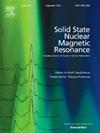从弛豫和Floquet理论推导的动态魔角自旋核磁共振的简单公式
IF 2.4
3区 化学
Q4 CHEMISTRY, PHYSICAL
引用次数: 0
摘要
A. J. Vega在一篇颇有见地的论文中提出了一种简单的方法[J]。粉剂。在两个位置旋转跳跃运动的情况下,应用reason . 65(1985) 252-267]计算化学交换对魔角旋转(MAS)核磁共振谱的影响。对于快慢交换的极限情况,这种方法只需要T2的两个基本表达式,并与任意运动速率和旋转频率的精确数值计算进行了比较。这一比较证明了弛豫理论(RT)在计算快速交换线形时的应用,而最初由A. Schmidt和S. Vega导出的慢交换T2时间常数的应用是正确的。化学。物理学报87(1987)6895-6907]使用的floquet -摄动理论(FPT)不能解释旋转边带线宽的差异。在本文中,完整的FPT (cFPT)表达的MAS频谱被证明可以解释在慢交换制度中观察到的微分边带展宽的所有细节。此外,RT和cFPT解决方案可以深入了解分子动力学对MAS光谱的影响,并显着减少了计算时间。使用RT和cFPT公式的计算过程产生的线形模拟与精确的数值结果非常吻合,除非在中间交换制度中,边带线宽与MAS速率相当或大于MAS速率。这在实践中是一个小缺点,因为快速松弛会使定量测量变得困难。本文章由计算机程序翻译,如有差异,请以英文原文为准。

A simple formulation of dynamic magic-angle spinning NMR derived from relaxation and Floquet theories
A simple method proposed in an insightful paper by A. J. Vega [J. Magn. Reson. 65 (1985) 252–267] is applied for calculating the effects of chemical exchange on magic-angle spinning (MAS) NMR spectra in the case of a two-site rotational jump motion. This approach which only requires two basic expressions of for the limiting cases of fast and slow exchange is compared with exact numerical calculations for arbitrary rates of motion and spinning frequencies. This comparison justifies the application of relaxation theory (RT) to calculate fast-exchange lineshapes but the slow-exchange time constant originally derived by A. Schmidt and S. Vega [J. Chem. Phys. 87 (1987) 6895–6907] using Floquet-perturbation theory (FPT) fails to account for the differences in the spinning sideband linewidths. In this paper, the complete FPT (cFPT) expression of the MAS spectrum is shown to account for all details of differential sideband broadening observed in the slow-exchange regime. Moreover, the RT and cFPT solutions give insight into the effects of molecular dynamics on the MAS spectra and decrease dramatically the computation time. The calculation procedure using the RT and cFPT formulas yield lineshape simulations that are in very good agreement with exact numerical results except in the intermediate-exchange regime when the sideband linewidths become comparable with or larger than the MAS rate. This is a minor drawback in practice as fast relaxation then makes quantitative measurements difficult.
求助全文
通过发布文献求助,成功后即可免费获取论文全文。
去求助
来源期刊
CiteScore
5.30
自引率
9.40%
发文量
42
审稿时长
72 days
期刊介绍:
The journal Solid State Nuclear Magnetic Resonance publishes original manuscripts of high scientific quality dealing with all experimental and theoretical aspects of solid state NMR. This includes advances in instrumentation, development of new experimental techniques and methodology, new theoretical insights, new data processing and simulation methods, and original applications of established or novel methods to scientific problems.

 求助内容:
求助内容: 应助结果提醒方式:
应助结果提醒方式:


